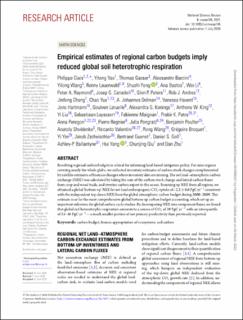| dc.contributor.author | Ciais, Philippe | |
| dc.contributor.author | Yao, Yitong | |
| dc.contributor.author | Gasser, Thomas | |
| dc.contributor.author | Baccini, Alessandro | |
| dc.contributor.author | Wang, Yilong | |
| dc.contributor.author | Lauerwald, Ronny | |
| dc.contributor.author | Peng, Shushi | |
| dc.contributor.author | Bastos, Ana | |
| dc.contributor.author | Li, Wei | |
| dc.contributor.author | Raymond, Peter A | |
| dc.contributor.author | Canadell, Josep G. | |
| dc.contributor.author | Peters, Glen Philip | |
| dc.contributor.author | Andres, Robert J. | |
| dc.contributor.author | Chang, Jinfeng | |
| dc.contributor.author | Yue, Chao | |
| dc.contributor.author | Dolman, A. Johannes | |
| dc.contributor.author | Haverd, Vanessa | |
| dc.contributor.author | Hartmann, Jens | |
| dc.contributor.author | Laruelle, Goulven | |
| dc.contributor.author | Konings, Alexandra G | |
| dc.contributor.author | King, Anthony W | |
| dc.contributor.author | Liu, Yi | |
| dc.contributor.author | Luyssaert, Sebastiaan | |
| dc.contributor.author | Maignan, Fabienne | |
| dc.contributor.author | Patra, Prabir K. | |
| dc.contributor.author | Peregon, Anna | |
| dc.contributor.author | Regnier, Pierre | |
| dc.contributor.author | Pongratz, Julia | |
| dc.contributor.author | Poulter, Ben | |
| dc.contributor.author | Shvidenko, Anatoly | |
| dc.contributor.author | Valentini, Riccardo | |
| dc.contributor.author | Wang, Rong | |
| dc.contributor.author | Broquet, Grégoire | |
| dc.contributor.author | Yin, Yi | |
| dc.contributor.author | Zscheischler, Jakob | |
| dc.contributor.author | Guenet, Bertrand | |
| dc.contributor.author | Goll, Daniel S. | |
| dc.contributor.author | Ballantyne, Ashley P. | |
| dc.contributor.author | Yang, Hui | |
| dc.contributor.author | Qiu, Chunjing | |
| dc.contributor.author | Zhu, Dan | |
| dc.date.accessioned | 2022-03-24T09:45:04Z | |
| dc.date.available | 2022-03-24T09:45:04Z | |
| dc.date.created | 2022-02-25T15:21:32Z | |
| dc.date.issued | 2021 | |
| dc.identifier.citation | National Science Review. 2021, 8 (2), . | en_US |
| dc.identifier.issn | 2095-5138 | |
| dc.identifier.uri | https://hdl.handle.net/11250/2987265 | |
| dc.description.abstract | Resolving regional carbon budgets is critical for informing land-based mitigation policy. For nine regions covering nearly the whole globe, we collected inventory estimates of carbon-stock changes complemented by satellite estimates of biomass changes where inventory data are missing. The net land–atmospheric carbon exchange (NEE) was calculated by taking the sum of the carbon-stock change and lateral carbon fluxes from crop and wood trade, and riverine-carbon export to the ocean. Summing up NEE from all regions, we obtained a global ‘bottom-up’ NEE for net land anthropogenic CO2 uptake of –2.2 ± 0.6 PgC yr−1 consistent with the independent top-down NEE from the global atmospheric carbon budget during 2000–2009. This estimate is so far the most comprehensive global bottom-up carbon budget accounting, which set up an important milestone for global carbon-cycle studies. By decomposing NEE into component fluxes, we found that global soil heterotrophic respiration amounts to a source of CO2 of 39 PgC yr−1 with an interquartile of 33–46 PgC yr−1—a much smaller portion of net primary productivity than previously reported. | en_US |
| dc.language.iso | eng | en_US |
| dc.publisher | Oxford Academic | en_US |
| dc.rights | Navngivelse 4.0 Internasjonal | * |
| dc.rights.uri | http://creativecommons.org/licenses/by/4.0/deed.no | * |
| dc.subject | carbon budget | en_US |
| dc.subject | human appropriation of ecosystems | en_US |
| dc.subject | soil carbon | en_US |
| dc.title | Empirical estimates of regional carbon budgets imply reduced global soil heterotrophic respiration | en_US |
| dc.type | Journal article | en_US |
| dc.type | Peer reviewed | en_US |
| dc.description.version | publishedVersion | en_US |
| dc.source.pagenumber | 0 | en_US |
| dc.source.volume | 8 | en_US |
| dc.source.journal | National Science Review | en_US |
| dc.source.issue | 2 | en_US |
| dc.identifier.doi | 10.1093/nsr/nwaa145 | |
| dc.identifier.cristin | 2005594 | |
| cristin.ispublished | true | |
| cristin.fulltext | original | |
| cristin.qualitycode | 1 | |

